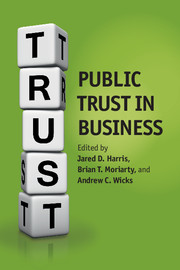Book contents
- Frontmatter
- Contents
- List of figures
- List of tables
- Notes on contributors
- Preface: discovering new territory in public trust in business
- Acknowledgments
- 1 Public trust in business: what’s the problem and why does it matter?
- Part I Trusting the institution of business
- Part II Public trust and business organizations
- 7 Public trust and trust in particular firm–stakeholder interactions: a theoretical model and implications for management
- 8 Creating more trusting and trustworthy organizations: exploring the foundations and benefits of presumptive trust
- 9 Building trust through reputation management
- 10 Can trust flourish where institutionalized distrust reigns?
- 11 Roles of third parties in trust repair: lessons from high-tech alliances for public trust
- 12 The repair of public trust following controllable or uncontrollable organizational failures: a conceptual framework
- 13 Toward a better understanding of public trust in business
- Index
- References
10 - Can trust flourish where institutionalized distrust reigns?
Published online by Cambridge University Press: 05 July 2014
- Frontmatter
- Contents
- List of figures
- List of tables
- Notes on contributors
- Preface: discovering new territory in public trust in business
- Acknowledgments
- 1 Public trust in business: what’s the problem and why does it matter?
- Part I Trusting the institution of business
- Part II Public trust and business organizations
- 7 Public trust and trust in particular firm–stakeholder interactions: a theoretical model and implications for management
- 8 Creating more trusting and trustworthy organizations: exploring the foundations and benefits of presumptive trust
- 9 Building trust through reputation management
- 10 Can trust flourish where institutionalized distrust reigns?
- 11 Roles of third parties in trust repair: lessons from high-tech alliances for public trust
- 12 The repair of public trust following controllable or uncontrollable organizational failures: a conceptual framework
- 13 Toward a better understanding of public trust in business
- Index
- References
Summary
EXECUTIVE SUMMARY
the situation
The global financial crisis has made one thing abundantly clear: trusting too much, particularly without having any reliable control mechanisms in place, is a very risky strategy. If we trust too much and ignore the possibility of opportunistic behavior, greed, and fraud, we are likely to be disappointed and bitterly regret it.
key questions
What can provide protection from the forces of untamed capitalism? Clearly, trust and distrust have their legitimate places in business relationships. The crucial question, however, is how these two mechanisms may fruitfully coexist.
new knowledge
With reference to the two-tiered governance systems of incorporated companies in Austria and Germany, it is shown how interpersonal trust can coexist with institutionalized distrust mechanisms within organizations.
Reliance on a dominant form of interpersonal trust between organizational members, meant to create checks and balances within the network, could result in negative effects such as complicity and corruption. The latter, however, can be avoided by strong institutionalized forms of distrust that exist alongside trust within the organization. Such structures may be conducive to (re)establishing and maintaining the perceived trustworthiness of business organizations.
- Type
- Chapter
- Information
- Public Trust in Business , pp. 266 - 289Publisher: Cambridge University PressPrint publication year: 2014
References
- 2
- Cited by



